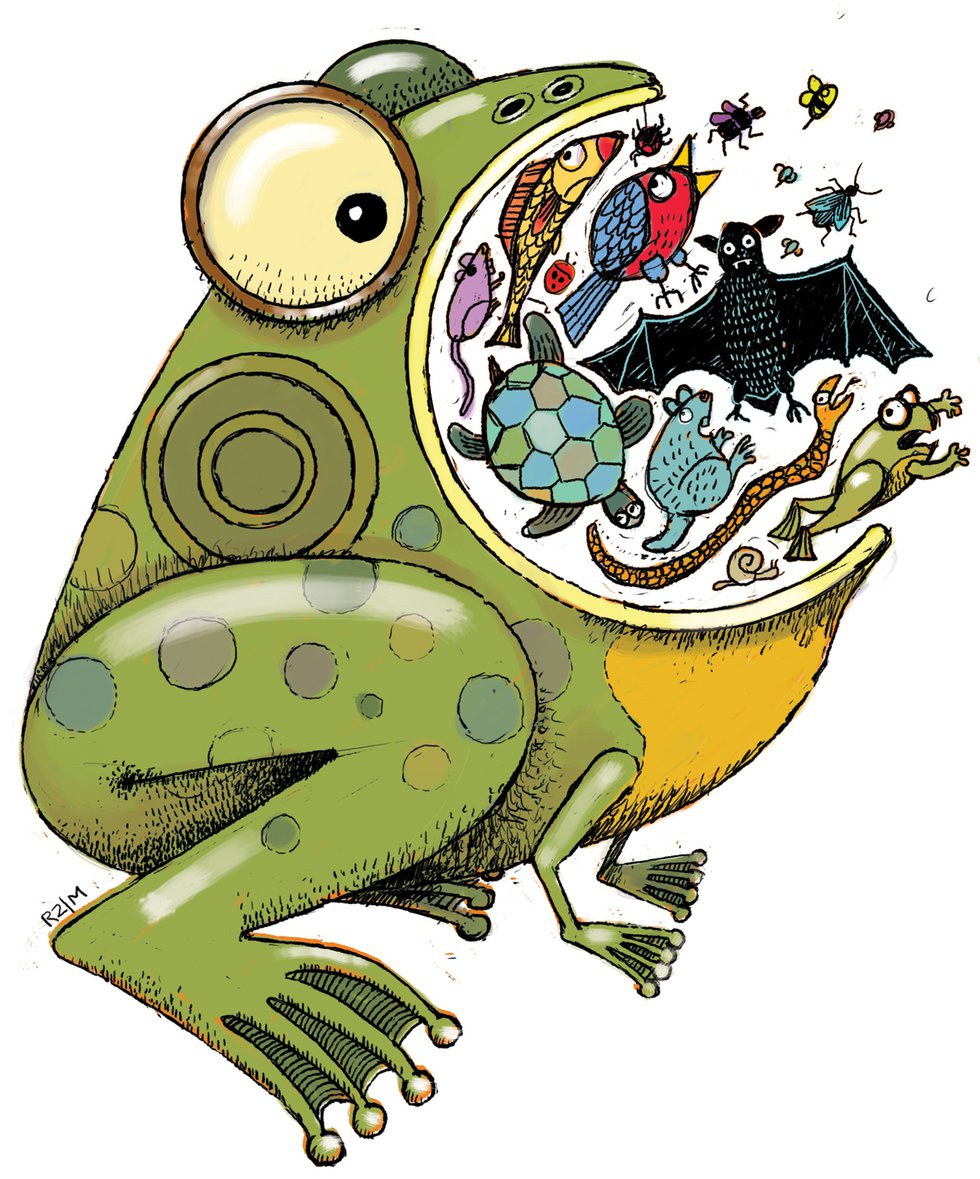The American bullfrog is a king among amphibians.

Illustration by Robert Meganck
It’s no insult to the American bullfrog that you might be challenged to distinguish it from pond scum. That is, you could be gazing idly at a shallow pondscape, the medley of silt and rotting leaves, drifting weeds and algae—and it might be some little while before it occurs to you, with a sudden, small start of recognition, that you have been staring down all the while upon a frog lurking, mottled against the backdrop. It may also strike you at this moment that the frog you are looking at is not a small one. And you might marvel that, for an amphibian roughly the size of an overdeveloped grapefruit with legs, it does a remarkably good job of hiding in plain sight.
In fact, the American bullfrog is the largest frog in North America—a mature male can weigh more than a pound and reach a length of as much as 8 inches. Their size makes these frogs fearsome predators, and so the bullfrog’s omnivorous diet consists rather literally of almost whatever can be stuffed in its big mouth, anything from fish, snails, spiders and beetles to turtles, snakes, rodents, other bullfrogs and even birds and bats; indeed, bullfrogs eating things represents something of a minor sub-genre on YouTube.
However, their size also makes the frogs themselves a tempting meal for a range of other creatures, including snakes, turtles, bigger fish, raccoons, some birds and, of course, humans too, though in that case it’s mostly the legs that get eaten—baked, grilled, sautéed, stewed, caramelized, fricasseed and fried.
The American bullfrog is native to the Central and Eastern U.S., but it is an introduced species west of the Rockies; a healthy appetite for frogs’ legs, dating back to the early 20th century, is considered one probable reason to blame for its westward migration.
The American bullfrog also has spread to South America, Hawaii, Europe, Asia and the Caribbean, likely through the aquarium and pet trade as well as importation for eating. In some areas it has become an invasive pest, crowding out and gobbling up native species. It enjoys the benefit of a combination of traits that make it highly adaptable, including that omnivorous appetite, a fondness for warm, nutrient-enriched waterways, a lengthy breeding season and the ability to travel surprisingly long distances over land, hopping miles to populate entire watersheds.
Female bullfrogs lay as many as 20,000 eggs at a go, and the resulting hatchlings may spend up to several years as tadpoles—though when you imagine “tadpole” here, scale up to something the length of a man’s hand. As tadpoles, they live off algae and aquatic plants and insects before losing their tails and graduating to the adult buffet. In the transition from tadpole to frog, they also, like other amphibians, replace their gills with lungs—although mature bullfrogs continue to spend their lives in and around water. American bullfrogs can live for as long as 16 years in captivity, but the average lifespan in the wild is about half that. It probably helps stretch out their days that they spend the cold months hibernating, burying themselves in mud.
Bullfrogs are of course known for their resonant, bass-note croak, which can be heard for as far as a quarter of a mile. It is supposed to resemble—allowing for a certain stretch of the imagination—the distant bellowing of a bull. The croak is termed by herpetologists an “advertisement call,” and what it is advertising is a Barry White-style invitation for the ladies to stop on by. (As a side note, waters that host a variety of frog species may yield of a summer evening an entire ensemble of frog croaks, chirrups and trills, in what is called a “mixed chorus.”)
And speaking of amphibian romance, should you hold the conviction that among the frogs there is surely an enchanted prince to kiss, you can improve your odds of scoring royalty by knowing that a male adult bullfrog can be distinguished from a female by the size of the round-shaped tympanum—a hearing organ—found to the sides of the frog’s eyes, which in males is much larger than the eyes. However, before you go snogging with frogs, you might want to check your sources. In some versions of the story of the frog prince, the disgusted princess does not kiss but rather flings the frog against a wall to effect its transformation into human form.
But whether or not there are any princes among the bullfrogs, bullfrogs are certainly kings among the frogs. So scientists were surprised that, despite the frog’s impressive size and powerful legs, the longest lab-reported leap for the species was a relatively anemic 4.3 feet. In 2009, some intrepid researchers sought alternative data at the Calaveras County Fair in California, where the American bullfrog is the star of a jumping-frog competition inspired by the Mark Twain story. (You can rent a frog for the contest, or you can BYOF.) With more than 3,000 jumps recorded, the scientists declared that the leapingest frog among the contestants had covered an awe-inspiring 7.2 feet in one jump. Which is certainly something worth croaking about.









